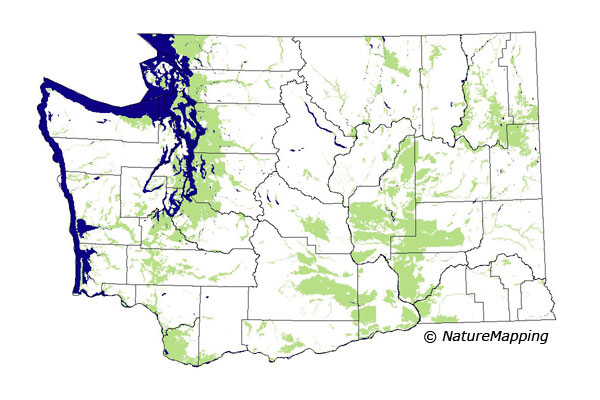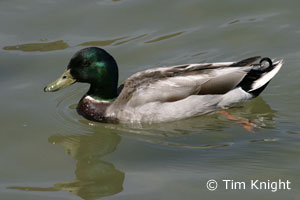


Mallard (Anas platyrhynchos)
Description:
Both sexes have bright orange feet and a purple-blue speculum (a bright
blue rectangle of color) with both sides outlined in white at the hind
end of the wing where it joins the body. It is easy to tell the males
from the female mallards because the male mallards have grayish or
brownish feathers, glossy green colored head, white collar around the
neck, purple breast, and curly tall feathers. The male has very curly
tail feathers. The smaller female is brown, black and white to help her
blend in with the vegetation (see photo below).
Calls:
Female gives a loud series of quacks. Male makes softer, rasping "rab," also a grunt and whistle during display. Wings whistle in flight. Range: The mallard is the best known and possibly most abundant wild duck in the Northern Hemisphere as it is common in North America, Northern Central America, much of Europe, Asia, and America. In summer the mallard can be seen throughout Alaska and much of Canada and northern United States. Nesting takes place primarily in the prairie provinces of Canada. 
Click the range map to learn more about the distribution of Mallards in Washington. Habitat: Mallards are most likely found on shallow bodies of fresh water, on lakes, marshes and even flooded fields. Diet: Mallards feed by "dabbling" and upending, meaning that they tip their bodies into water, bill first, tail in the air to reach below the surface with its bill in the shallows of ponds, lakes, streams and swamps. They do not usually dive below the surface, except that young birds or molting (flightless) adults sometimes dive to avoid danger. Their diet consists mainly of seeds of grasses, pondweeds and other aquatic vegetation. They will also eat mollusks, insects, small fish, tadpoles, freshwater snails, fish eggs, and frogs. Nesting: A mallard hen (female) lays one egg per day and produces between five and 14 light green eggs. She will incubate the eggs for about 26-28 days before they hatch. The ducklings are lead to water as soon as their soft, downy feathers are dry and they first fly about 2 months after hatching. Behavior: They swim with their tail held above the water and, when they are alarmed, they spring directly out of the water and into the air. The sudden flight of Mallards can make quite a spectacular sight. Did you know?

photos by Tim Knight and Natures Pics Animal silhouettes available to purchase » More Information: Home | About Us | How to Participate | Biodiversity Modules | Projects | Maps | News | Resources |